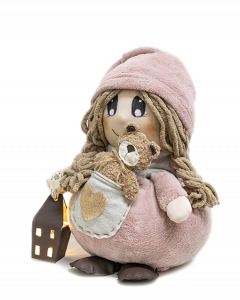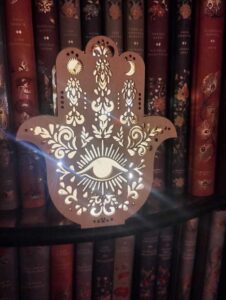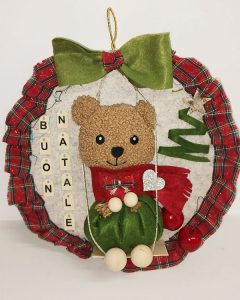
Cloth dolls, also known as rag dolls, represent one of the most beloved toys ever, handed down from generation to generation. These handmade objects are not just simple toys, but true symbols of craftsmanship, creativity and emotional bonding.
In this article we will explore their history, the materials they are made from and the art of craftsmanship that makes them unique and super sought after.
History of cloth dolls
Cloth dolls boast ancient origins and have their roots in different cultures around the world. Since ancient times, children have played with dolls made from natural and readily available materials, such as cloth, straw and wool.
Origins in antiquity
The earliest evidence of dolls dates back to Ancient Egyptian times, where rag figures stuffed with straw have been found in children’s tombs. These dolls were simple and rudimentary, but they were considered true talismans.
The ancient Greeks and Romans also had their own versions of cloth dolls, often used not only as toys but also in religious ceremonies. The dolls were often offered to the gods as a sign of passage from childhood to adulthood.
The Middle Ages and the Renaissance
In the Middle Ages, doll making became more widespread in Europe. Cloth dolls were made by mothers for their children using scraps of leftover fabric. The simplicity of medieval creations contrasted with the increasing complexity of Renaissance dolls, which began to become decorative and luxury items.
In the Renaissance, dolls were often dressed in elaborate outfits, reflecting the fashion of the time. These mannequin dolls were used to showcase new clothing designs to European courts.
The modern era and global spread
With the Industrial Revolution, doll making began to become more affordable and widespread. However, handmade cloth dolls remained popular, especially in peasant families, where they were made from salvaged fabrics. In the United States, the iconic Rag Dolls were born in the 19th century, featuring cloth bodies and hand-embroidered details.
During the 20th century, industrialization led to the creation of dolls made of plastic and synthetic materials, but rag dolls never lost their appeal.
Even today, thanks to the rediscovery of handicrafts and the growing focus on sustainable products, these dolls are experiencing a new youth
Materials used in cloth dolls
One of the most fascinating aspects of cloth dolls is the variety of materials from which they can be made. Each artisan chooses fabrics and decorative elements based on the style and end use of the doll.
Main fabrics
Fabrics are the main component of a cloth doll. Among the most widely used are:
- Cotton: soft and durable, it is one of the most widely used materials for making dolls. Easy to work with and available in many color variations.
- Flax: valued for its robustness and natural appearance.
- Velvet: used to create more refined or decorative dolls.
- Fleece and felt: very soft, ideal for dolls dedicated to toddlers.
Padding
Stuffing is essential to give shape and structure to the doll. Some of the most common options are:
- Carded wool: a natural material that offers unique softness.
- Raw cotton: used in traditional dolls.
- Polyester fiber: very light and hypoallergenic.
- Recycled materials: such as old textiles or fabric scraps, used from a sustainable perspective.
Details and finishing touches
Details make all the difference in a cloth doll. For eyes, buttons, beads or hand embroidery can be used. Hair can also be made from different materials, such as wool, cotton threads, or woven fabrics.
The art of craftsmanship in cloth dolls
Creating a rag doll is an art that requires patience, precision and creativity. Each step in the process contributes to making the doll a unique piece.
Creation process
- Design: the craftsman designs the doll model, deciding on the size and details.
- Fabric cutting: fabric pieces are cut out according to the pattern.
- Stitching and assembly: the various pieces are stitched together, leaving an opening to insert padding.
- Padding: the body is filled to give structure to the doll.
- Face and hair decoration: eyes, mouth and other details are added by embroidery or painting.
- Adding clothes and accessories: often hand-sewn to make the doll even more special.
The value of sustainable craftsmanship
In an age of mass production, handicrafts provide a more sustainable and authentic alternative. Buying a handmade cloth doll means supporting local artisans and contributing to the reduction of textile waste.
Many doll makers, such as those from Favole Green, use recycled materials and eco-friendly practices to give new life to unused fabrics.
Cloth dolls in the modern world
Today, cloth dolls are not only children’s toys, but also collectibles and artistic decorations.
Many people choose personalized dolls that represent specific somatic traits, cultural characteristics, or traditional clothing. In some cases, they are used as educational tools to teach children important values, such as respect for the environment and handicrafts.
With the growing demand for unique and sustainable products, rag dolls continue to be a popular choice. Whether given as a gift to a child, used as a decorative item, or kept as family heirlooms, these dolls represent a small piece of handcrafted history and love.
To summarize
Cloth dolls are more than just toys. They tell stories of tradition, creativity and passion. Their long history and increasing focus on craftsmanship make them a valuable choice for those who want a unique and carefully made object.
If you want a doll that has a soul, made from natural materials and with love, handmade cloth dolls are the perfect choice!



